For seventy years, a prayer book moldered in the closet of a family in France, passed down from one generation to the next. Its mildewed parchment pages were stiff and contorted, tarnished by burn marks and waxy smudges. Behind the text of the prayers, faint Greek letters marched in lines up the page, with an occasional diagram disappearing into the spine.
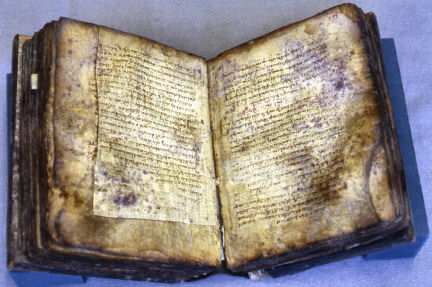
The owners wondered if the strange book might have some value, so they took it to Christie’s Auction House of London. And in 1998, Christie’s auctioned it off—for two million dollars.
For this was not just a prayer book. The faint Greek inscriptions and accompanying diagrams were, in fact, the only surviving copies of several works by the great Greek mathematician Archimedes.
An intensive research effort over the last nine years has led to the decoding of much of the almost-obliterated Greek text. The results were more revolutionary than anyone had expected. The researchers have discovered that Archimedes was working out principles that, centuries later, would form the heart of calculus and that he had a more sophisticated understanding of the concept of infinity than anyone had realized.
Archimedes wrote his manuscript on a papyrus scroll 2,200 years ago. At an unknown later time, someone copied the text from papyrus to animal-skin parchment. Then, 700 years ago, a monk needed parchment for a new prayer book. He pulled the copy of Archimedes’ book off the shelf, cut the pages in half, rotated them 90 degrees, and scraped the surface to remove the ink, creating a palimpsest—fresh writing material made by clearing away older text. Then he wrote his prayers on the nearly-clean pages.
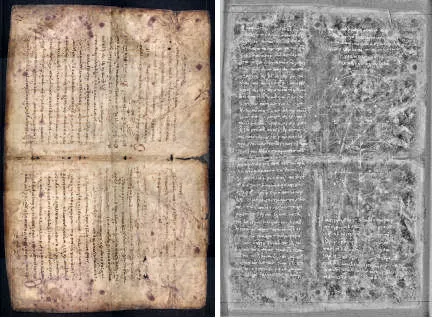
What happened to the monk’s book after that is unclear, but in 1908, Johan Ludwig Heiberg, a Danish philologist, discovered it in a library in Constantinople. He was astonished to find that the book contained previously unknown texts by Archimedes. He studied the book in detail, puzzling out the faint letters with a microscope. His efforts brought the works to the attention of scholars around the world, but after he had completed his transcription, the book again disappeared until nearly a decade ago, when it was auctioned off at Christie’s.
The book’s anonymous buyer has funded an enormous research project on the volume. First, intensive conservation and restoration stabilized the condition of the book itself. Then the researchers took digital pictures of it in different wavelengths of light, creating a multi-spectral image that could be manipulated to reveal the text by Archimedes. On four of the pages, forged paintings covered the entire text, so the researchers used x-ray fluorescence imaging to peek beneath the paintings and decipher the obscured text.
Two of the texts hiding in the prayer book have not appeared in any other copy of Archimedes’s work, so no one but Heiberg had studied them until now. One of them, titled The Method, has special historical significance. It could be considered the earliest known work on calculus.
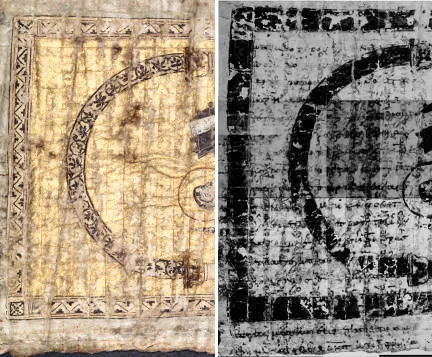
Archimedes wrote The Method almost two thousand years before Isaac Newton and Gottfried Wilhelm von Leibniz developed calculus in the 1700s. Reviel Netz, an historian of mathematics at Stanford University who transcribed the text, says that the examination of Archimedes’ work has revealed “a new twist on the entire trajectory of Western mathematics.”
In The Method, Archimedes was working out a way to compute the areas and volumes of objects with curved surfaces, which was also one of the problems that motivated Newton and Leibniz. Ancient mathematicians had long struggled to “square the circle” by calculating its exact area. That problem turned out to be impossible using only a straightedge and compass, the only tools the ancient Greeks allowed themselves. Nevertheless, Archimedes worked out ways of computing the areas of many other curved regions.
Such problems are tricky because solving them directly requires slicing up curved areas into infinitely many areas with straight boundaries. But the concept of infinity is a slippery and troublesome one that can quickly lead to paradox.
The Greek philosopher Aristotle built defenses against infinity’s vexing qualities by distinguishing between the “potential infinite” and the “actual infinite.” An infinitely long line would be actually infinite, whereas a line that could always be extended would be potentially infinite. Aristotle argued that the actual infinite didn’t exist.
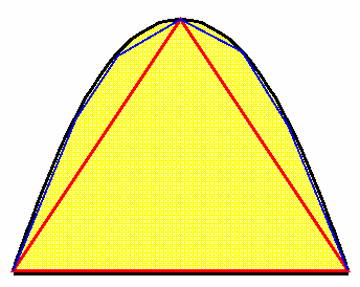
Archimedes developed rigorous methods of dealing with infinity—still used today—in which he followed Aristotle’s injunction. For example, Archimedes proved that the area of a section of a parabola is four-thirds the area of the triangle inside it (shown in red in the diagram below). To do so, he built a straight-lined figure that’s an approximation of the curvy one. Then he showed that he could make the approximation as close as anyone could ever demand to both the section of the parabola and to four-thirds the area of the triangle.
Critically, Archimedes never claimed that by adding triangles forever, you could make the straight-line construction exactly equal to the section of the parabola. That would require an actual infinity of triangles. Instead, he just said that you can make the approximation as good as you like, so he was sticking with potential infinity.
Modern historians and mathematicians have always believed whenever Archimedes dealt with infinities, he kept strictly to the potential kind. But Netz, who transcribed the newly found text, says that the recent discoveries show that Archimedes indeed used the notion of actual infinity. Netz and the project’s lead researcher, William Noel of the Walters Art Museum in Baltimore, have co-authored a new book, The Archimedes Codex, which describes this discovery and the other facets of the project. It is scheduled for release on Nov. 1 of this year.
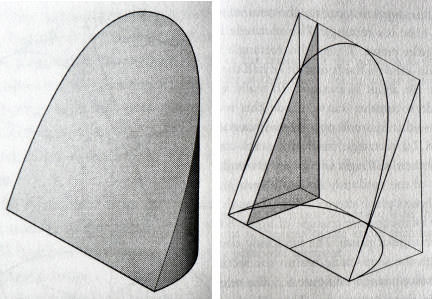
Archimedes’s key argument about infinity appears on pages so damaged that Heiberg had been unable to transcribe them. Archimedes calculated the volume of a body shaped something like a fingernail by enclosing it in a volume bounded by plane surfaces. But instead of making better and better approximations of the curved figure, as he had done with the parabolic section, he pondered a two-dimensional slice through the larger volume enclosing the smaller one.
Archimedes found a relationship between the full area of that slice, which was a section through the plane-sided volume, and the smaller area within it, which was a section through the curved shape. Then he argued that he could use that relationship to calculate the entire volume of the curved shape, because both the curved figure and the straight one contained the same number of slices. That number just happened to be infinity—actual infinity.
“The interesting breakthrough is that he is completely willing to operate with actual infinity,” Netz says, but he adds that “the argument is definitely not completely valid. He just had a strong intuition that it should work.” In this case, it did work, but it remained for Newton and Leibniz to figure out how to make the argument mathematically rigorous.
Newton and Leibniz also worked with actual infinity. Leibniz went so far as to say in a letter, “I am so in favor of the actual infinite that instead of admitting that Nature abhors it, as is commonly said, I hold that Nature makes frequent use of it everywhere, in order to show more effectively the perfections of its Author.”
Modern calculus no longer makes use of the actual infinite; it sticks with Aristotle’s distinction. Philosophers still argue over the legitimacy of the notion of actual infinity. Netz argues, however, that The Method reveals the originality and daring of Archimedes’s thought and shows that he anticipated some of the bold steps that would later lead to the full development of calculus.






